Observed Trends and Changes in Temperature and Precipitation Extreme Indices over Myanmar
Abstract
1. Introduction
2. Materials and Methods
2.1. Study Area
2.2. Data
2.3. Methods
2.3.1. Data Quality and Homogeneity Check
2.3.2. Climate Extreme Indices and Trend Identification
3. Results
3.1. Temperature and Precipitation Anomaly
3.2. Temperature and Precipitation Extreme Indices
3.2.1. Temperature Extreme Indices
3.2.2. Precipitation Extreme Indices
4. Discussion
5. Conclusions
- -
- Maximum temperature increasing rate is 0.38 °C/decade and this is higher than previous studies;
- -
- Continuous warming trend in maximum temperature exceed +0.5 °C than normal were observed from 2009 to 2015 for all years except 2011;
- -
- The overall rate of increase in maximum temperature is higher than that of the minimum temperature;
- -
- Warm extreme indices are more frequent than cool extreme indices;
- -
- Highest rate of increase temperature extreme indices was observed in the central region compared to the other regions;
- -
- Precipitation trends have been towards wetter conditions with more very heavy precipitation days since 1999;
- -
- Highest rate of precipitation extreme indices were detected in coastal region;
- -
- There is a strong link between ENSO and PRCPTOT in Myanmar.
Supplementary Materials
Author Contributions
Funding
Acknowledgments
Conflicts of Interest
References
- IPCC Climate Change 2013: The Physical Science Basis. Contribution of Working Group to the Fifth Assessment Report of the Intergovernmental Panel on Climate Change; Cambridge University Press: Cambridge, UK, 2013.
- IPCC Climate Change 2007: The Physical Science Basis. Contribution of Working Group I to the Fourth Assessment Report of the Intergovernmental Panel on Climate Change; Cambridge University Press: Cambridge, UK, 2007.
- Easterling, D.R.; Horton, B.; Jones, P.D.; Peterson, T.C.; Karl, T.R.; Parker, D.E.; Salinger, M.J.; Razuvayev, V.; Plummer, N.; Jamason, P.; et al. Maximum and minimum temperature trends for the Globe. Science 1997, 277, 364–367. [Google Scholar] [CrossRef]
- Kiktev, D.; Sexton, D.M.H.; Alexander, L.; Folland, C.K. Comparison of modeled and observed trends in indices of daily climate extremes. J. Clim. 2003, 16, 3560–3571. [Google Scholar] [CrossRef]
- Alexander, L.V.; Zhang, X.; Peterson, T.C.; Caesar, J.; Gleason, B.; Klein, T.A.M.G.; Haylock, M.; Collins, D.; Trewin, B.; Rahimzadeh, F.; et al. Global observed changes in daily climate extremes of temperature and precipitation. J. Geophys. Res. 2006, 111, D05109. [Google Scholar] [CrossRef]
- Donat, M.G.; Alexander, L.V.; Yang, H.; Durre, I.; Vose, R.; Dunn, R.J.H.; Willett, K.M.; Aguilar, E.; Brunet, M.; Caesar, J.; et al. Updated analyses of temperature and precipitation extreme indices since the beginning of the twentieth century: The HadEX2 dataset. J. Geophys. Res. 2013, 118, 2098–2118. [Google Scholar] [CrossRef]
- Manton, M.J.; Della-Marta, P.M.; Haylock, M.R.; Hennessy, K.J.; Nicholls, N.; Chambers, L.E.; Yee, D. Trends in extreme daily rainfall and temperature in Southeast Asia and the south Pacific: 1961–1998. Int. J. Climatol. 2001, 21, 269–284. [Google Scholar] [CrossRef]
- Griffiths, G.M.; Chambers, L.E.; Haylock, M.R.; Manton, M.J.; Nicholls, N.; Baek, H.J.; Zhai, P. Change in mean temperature as a predictor of extreme temperature change in the Asia-Pacific region. Int. J. Climatol. 2005, 25, 1301–1330. [Google Scholar] [CrossRef]
- Choi, G.; Collins, D.; Ren, G.; Trewin, B.; Baldi, M.; Fukuda, Y.; Zhou, Y. Changes in means and extreme events of temperature and precipitation in the Asia-Pacific Network region, 1955-2007. Int. J. Climatol. 2009, 29, 1906–1925. [Google Scholar] [CrossRef]
- Endo, N.; Matsumoto, J.; Lwin, T. Trends in precipitation extremes over Southeast Asia. SOLA 2009, 5, 168–171. [Google Scholar] [CrossRef]
- Caesar, J.; Alexander, L.V.; Trewin, B.; Tsering, K.; Sorany, L.; Vuniyayawa, V.; Sirabaha, S. Changes in temperature and precipitation extremes over the Indo-Pacific region from 1971 to 2005. Int. J. Climatol. 2011, 31, 791–801. [Google Scholar] [CrossRef]
- Yazid, M.; Humphries, U. Regional observed trends in daily rainfall indices of extremes over the Indochina Peninsula from 1960 to 2007. Climate 2015, 3, 168–192. [Google Scholar] [CrossRef]
- Almazroui, M.; Islam, M.N.; Dambul, R.; Jones, P.D. Trends of temperature extremes in Saudi Arabia. Int. J. Climatol. 2014, 34, 808–826. [Google Scholar] [CrossRef]
- Hoyos, C.D.; Webster, P.J. The role of intraseasonal variability in the nature of Asian monsoon precipitation. J. Clim. 2007, 20, 4402–4424. [Google Scholar] [CrossRef]
- Kreft, S.; Eckstein, D.; Melchior, I. Global Climate Risk Index 2017: Who Suffers Most from Extreme Weather Events? Weather-Related Loss Events in 2015 and 1996 to 2015; Germanwatch e.V.: Bonn, Germany, 2016; ISBN 978-3-943704-49-5. [Google Scholar]
- DMH. Myanmar Climate Report; Department of Meteorology and Hydrology (DMH), Ministry of Transport and Communications: Nay Pyi Taw, Myanmar, 2017.
- Eischeid, J.K.; Baker, C.B.B.; Karl, T.R.; Diaz, H.F. The Quality Control of Long-Term Climatological Data Using Objective Data Analysis. J. Appl. Meteorol. 1995, 34, 2787–2795. [Google Scholar] [CrossRef]
- Karl, T.R.; Tarpley, J.D.; Quayle, R.G.; Diaz, H.F.; Robinson, D.A.; Bradley, R.S. The recent climate record: What it can and cannot tell us. Rev. Geophys. 1989, 27, 405. [Google Scholar] [CrossRef]
- Aguilar, E.; Auer, I.; Brunet, M.; Peterson, T.C.; Wieringa, J. Guidelines on Climate Metadata and Homogenization; WMO-TD, No. 1186, WCDMP No. 53; World Meteorological Organization: Geneva, Switzerland, 2003; p. 55. [Google Scholar]
- Zhang, X.; Yang, F. RClimDex 1.0 User Manual; Climate Research Branch Environment Canada: Downsvies, ON, Canada, 10 September 2004; p. 22.
- Sharma, D.; Babel, M.S. Trends in extreme rainfall and temperature indices in the western Thailand. Int. J. Climatol. 2014, 34, 2393–2407. [Google Scholar] [CrossRef]
- You, Q.; Kang, S.; Aguilar, E.; Yan, Y. Changes in daily extremes in the eastern and central Tibetan Plateau during 1961–2005. J. Geophys. Res. Atm. 2008, 113, 1–17. [Google Scholar] [CrossRef]
- Shrestha, A.B.; Bajracharya, S.R.; Sharama, A.R.; Duo, C.; Kulkarni, A. Observed trends and changes in daily temperature and precipitation extremes over the Koshi river basin 1975–2010. Int. J. Climatol. 2016. [Google Scholar] [CrossRef]
- Wang, X.L.; Wen, Q.H.; Wu, Y. Penalized maximal t-test for detecting undocumented mean change in climate data series. J. Appl. Meteorol. 2006, 1–40. [Google Scholar] [CrossRef]
- Wang, X.L. Accounting for autocorrelation in detecting mean-shifts in climate data series using the penalized maximal t or F test. J. Appl. Meteorol. Climatol. 2008, 47, 2423–2444. [Google Scholar] [CrossRef]
- Wang, X.L. Penalized maximal F-test for detecting undocumented mean-shifts without trend change. J. Atmos. Ocean. Technol. 2008, 25, 368–384. [Google Scholar] [CrossRef]
- Wang, X.L.; Feng, Y. RHtestsV4 User Manual; Climate Research Division, Atmospheric Science and Technology Directorate, Science and Technology Branch, Environment Canada, July 2013; pp. 1–29. Available online: http://etccdi.pacificclimate.org/software.shtml (accessed on 15 November 2013).
- Vincent, L.A.; Peterson, T.C.; Barros, V.R.; Marino, M.B.; Rusticucci, M.; Carrasco, G.; Karoly, D. Observed trends in indices of daily temperature extremes in South America 1960–2000. J. Clim. 2005, 18, 5011–5023. [Google Scholar] [CrossRef]
- WMO. Guidelines on Analysis of Extremes in a Changing Climate in Support of Informed Decisions for Adaptation; WMO-TD No. 1500, WCDMP No. 72; World Meteorological Organization: Geneva, Switzerland, 2009; p. 52. [Google Scholar]
- Sen, P.K. Estimates of regression coefficient based on Kendall’s tau. J. Am. Stat. Assoc. 1968, 63, 1379–1389. [Google Scholar] [CrossRef]
- Mann, H.B. Non-parametric tests against trend. Econometrica 1945, 13, 245–259. [Google Scholar] [CrossRef]
- Kendall, M.G. Rank Correlation Methods; Charles Griffin: London, UK, 1975. [Google Scholar]
- NOAA. Global Climate Report—Annual 2016, National Centers for Environmental Information, National Oceanic and Atmospheric Administration. Available online: https://www.ncdc.noaa.gov/sotc/global/201613 (accessed on 10 June 2017).
- Myanmar’s National Adaptation Programme of Action (NAPA) to Climate Change. Available online: http://unfccc.int/resource/ docs/napa/mmr01.pdf (accessed on 13 July 2017).
- Hegerl, G.C.; Hoegh-Guldberg, O.; Casassa, G.; Hoerling, M.; Kovats, S.; Parmesan, C.; Pierce, P.; Stott, P. Good Practice Guidance Paper on Detection and Attribution Related to Anthropogenic Climate Change. In Meeting Report of the Intergovernmental Panel on Climate Change Expert Meeting on Detection and Attribution of Anthropogenic Climate Change; Stocker, T.F., Field, C.B., Qin, D., Barros, V., Plattner, G.-K., Tignor, M., Midgley, P.M., Ebi, K.L., Eds.; IPCC Working Group I Technical Support Unit, University of Bern: Bern, Switzerland, 2010. [Google Scholar]
- Trenberth, K.E.; Jones, P.D.; Ambenje, P.; Bojariu, R.; Easterling, D.; Tank, A.K.; Parker, D.; Rahimzadeh, F.; Renwick, J.A.; Rusticucci, M.; et al. Observations: Surface and Atmospheric Climate Change. In Climate Change 2007: The Physical Science Basis. Contribution of Working Group I to the Fourth Assessment Report of the Intergovernmental Panel on Climate Change; Cambridge University Press: Cambridge, UK; New York, NY, USA, 2007. [Google Scholar]
- Cinco, T.A.; de Guzman, R.G.; Hilario, F.D.; Wilson, D.M. Long-term trends and extremes in observed daily precipitation and near surface air temperature in the Philippines for the period 1951–2010. Atmos. Res. 2014, 145–146, 12–26. [Google Scholar] [CrossRef]
- Hansen, J.; Ruedy, R.; Sato, M.; Lo, K. Global surface temperature change. Rev. Geophys. 2010, 48, RG4004. [Google Scholar] [CrossRef]
- Christidis, N.; Stott, P.A.; Brown, S.; Hegerl, G.C.; Caesar, J. Detection of changes in temperature extremes during the second half of the 20th century. Geophys. Res. Lett. 2005, 32, 1–4. [Google Scholar] [CrossRef]
- Jones, P.D.; New, M.; Parker, D.E.; Martin, S.; Rigor, I.G. Surface air temperature and its changes over the past 150 years. Rev. Geophys. 1999, 37, 173–199. [Google Scholar] [CrossRef]
- Zhang, X.; Alexander, L.; Hegerl, G.C.; Jones, P.; Tank, A.K.; Peterson, T.C.; Trewin, B.; Zwiers, F.W. Indices for monitoring changes in extremes based on daily temperature and precipitation data. WIREs Clim Chang. 2011. [Google Scholar] [CrossRef]
- Qian, W.; Lin, X. Regional trends in recent temperature indices in China. Clim. Res. 2004, 27, 119–134. [Google Scholar] [CrossRef]
- Sheikh, M.M.; Manzoor, N.; Ashraf, J.; Adnan, M.; Collins, D.; Hameed, S.; Shrestha, M.L. Trends in extreme daily rainfall and temperature indices over South Asia. Int. J. Climatol. 2014. [Google Scholar] [CrossRef]
- Sen, R.N.; Kaur, S. Climatology of monsoon rains of Myanmar (Burma). Int. J. Climatol. 2000, 20, 913–928. [Google Scholar] [CrossRef]
- Sein, Z.M.M.; Ogwang, B.A.; Ongoma, V.; Ogou, F.K.; Batebana, K. Inter-annual variability of summer monsoon rainfall over Myanmar in relation to IOD and ENSO. J. Environ. Agric. Sci. 2015, 4, 28–36. [Google Scholar]
- NOAA. Historical El Niño and La Niña episodes (1950 to Present). National Centers for Environmental Information, National Oceanic and Atmospheric Administration. Available online: http://www.cpc.noaa.gov/products/analysis_monitoring/ensostuff/ ensoyears.shtml (accessed on 4 April 2017).
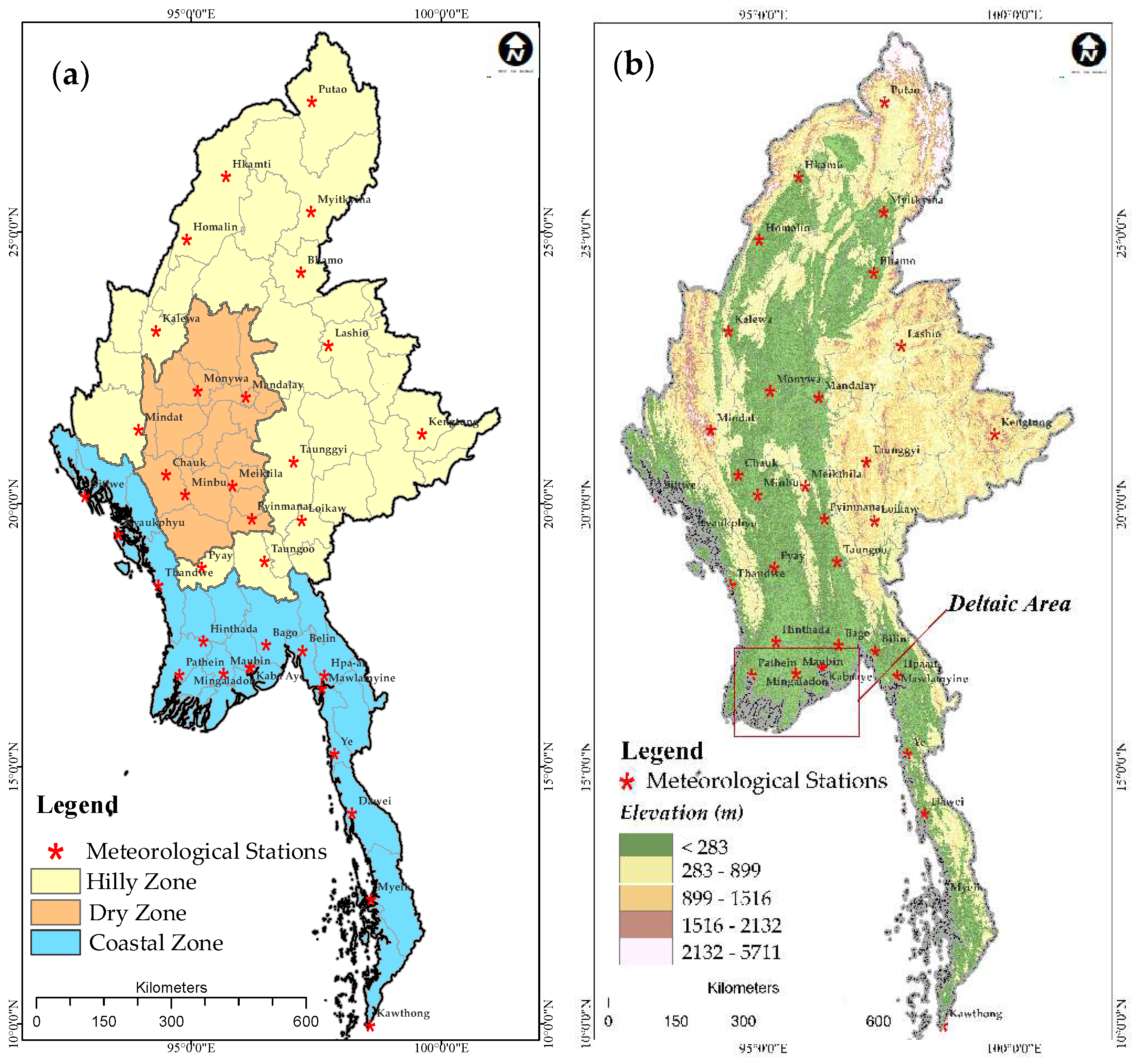
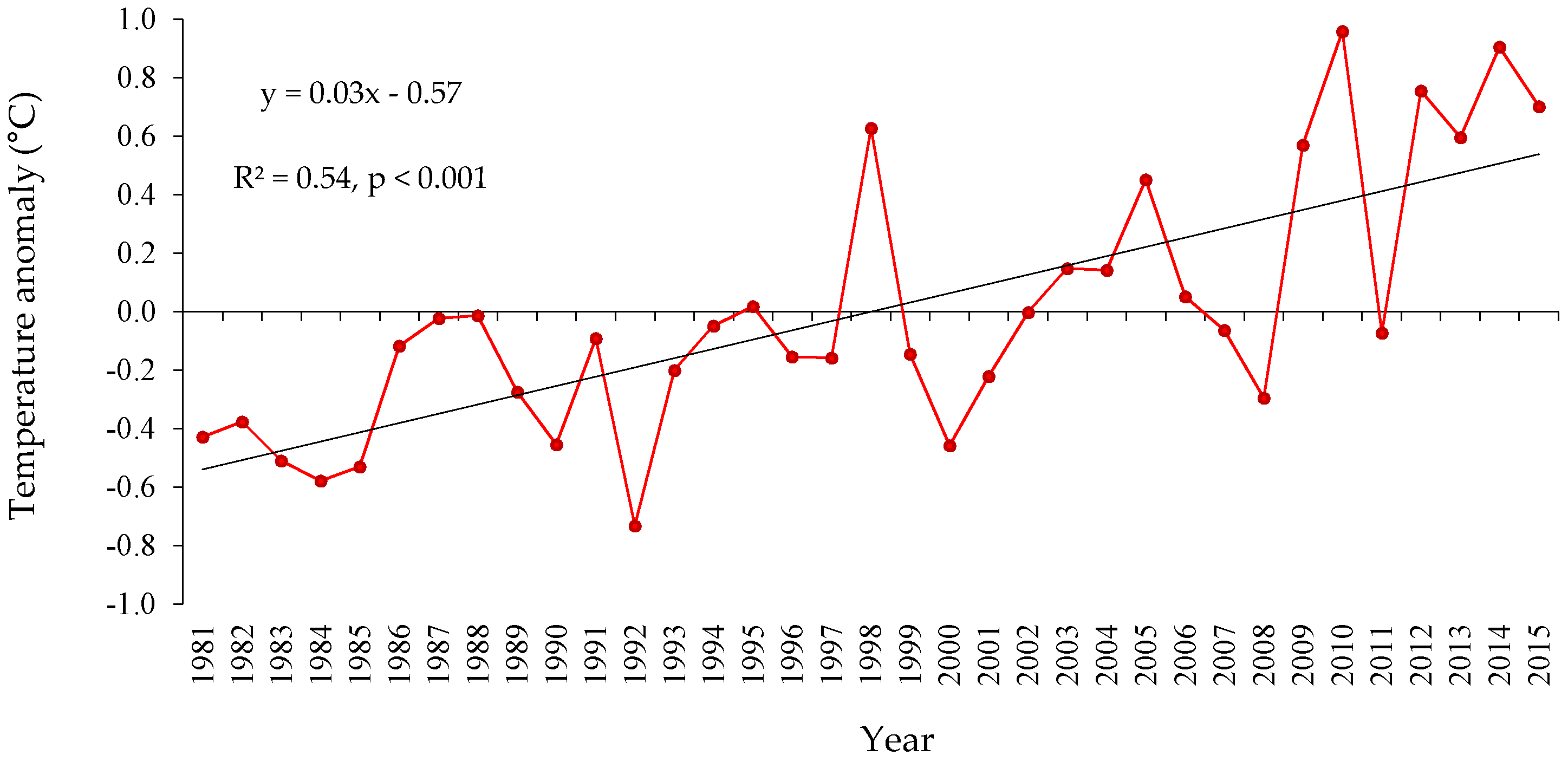
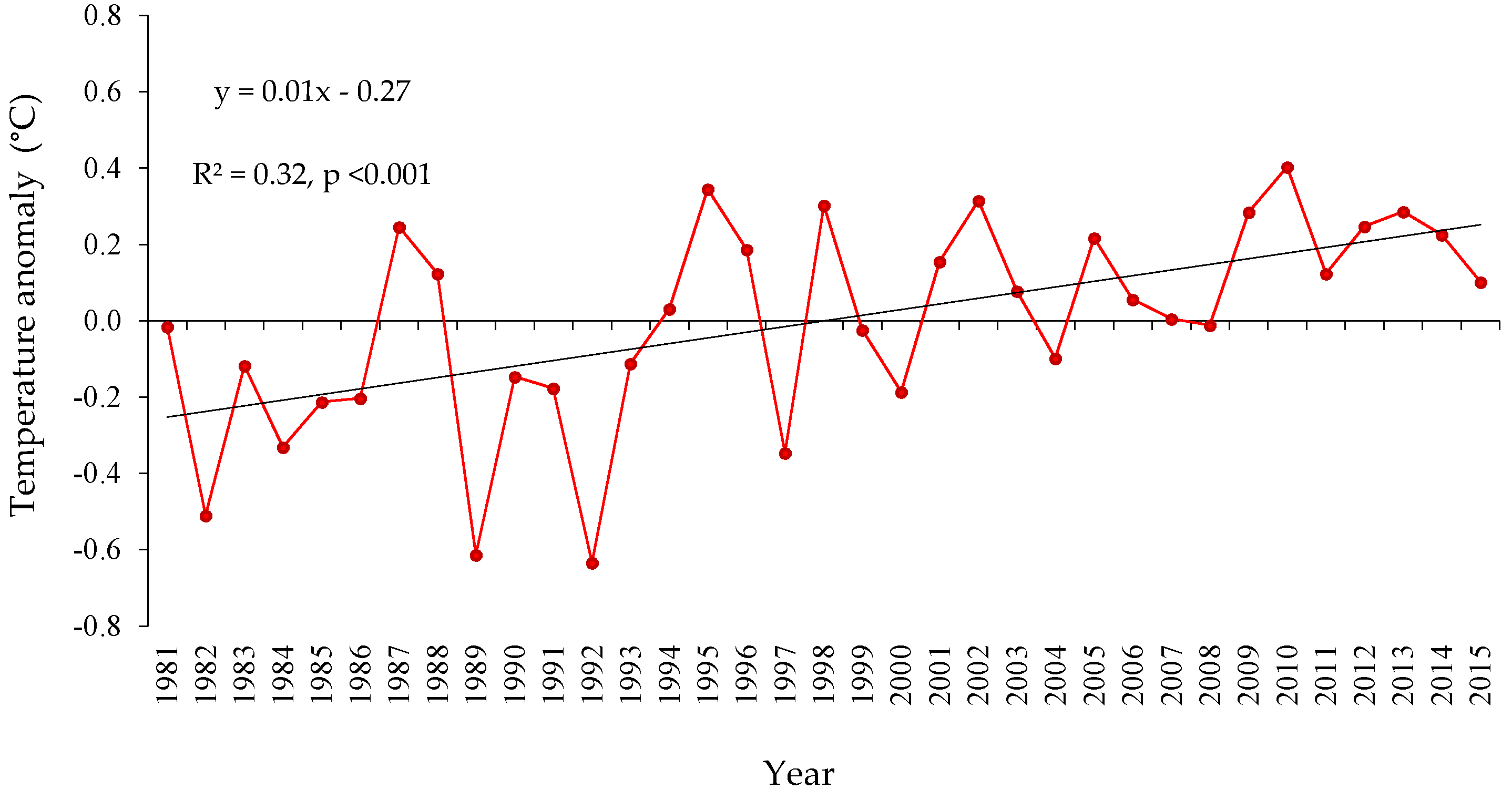
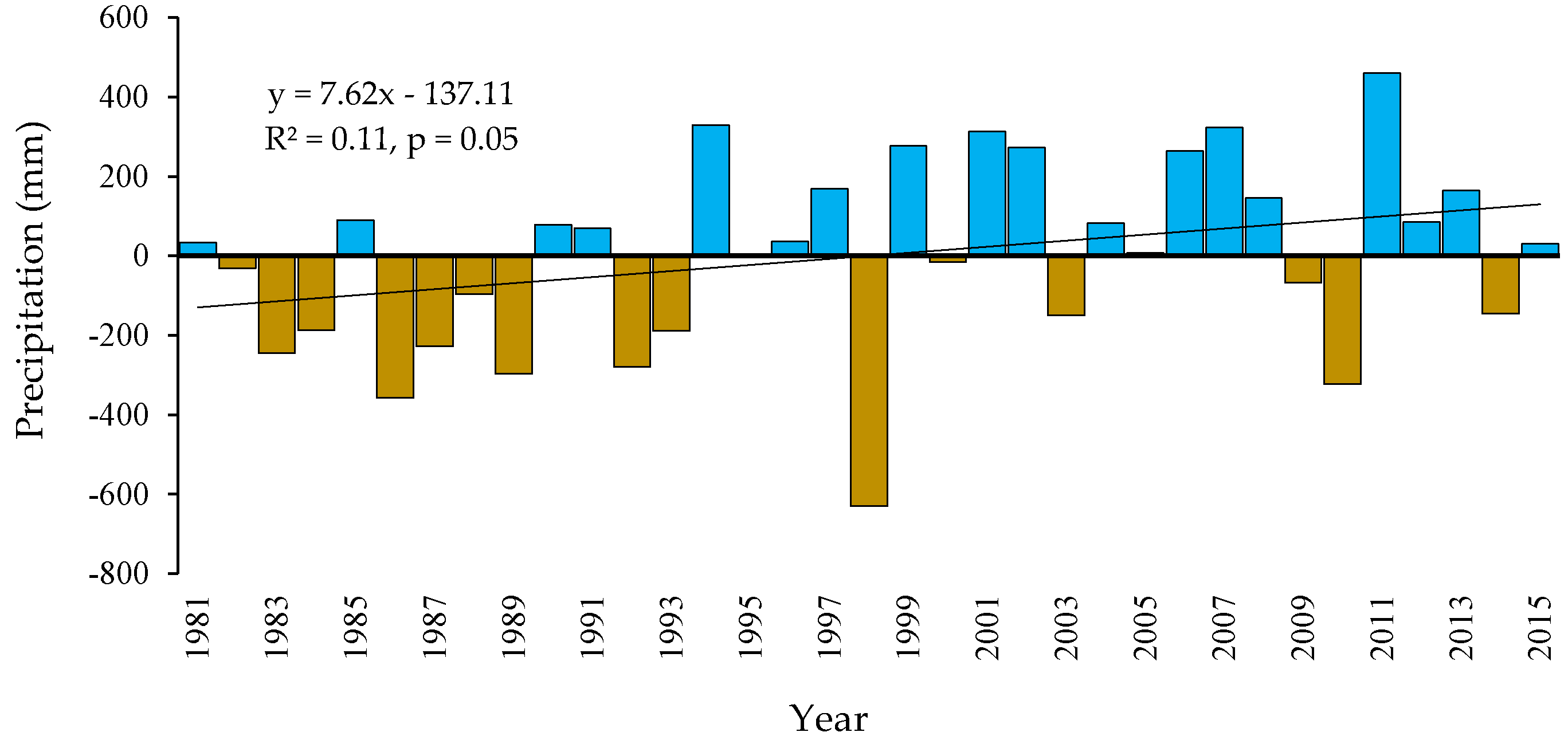
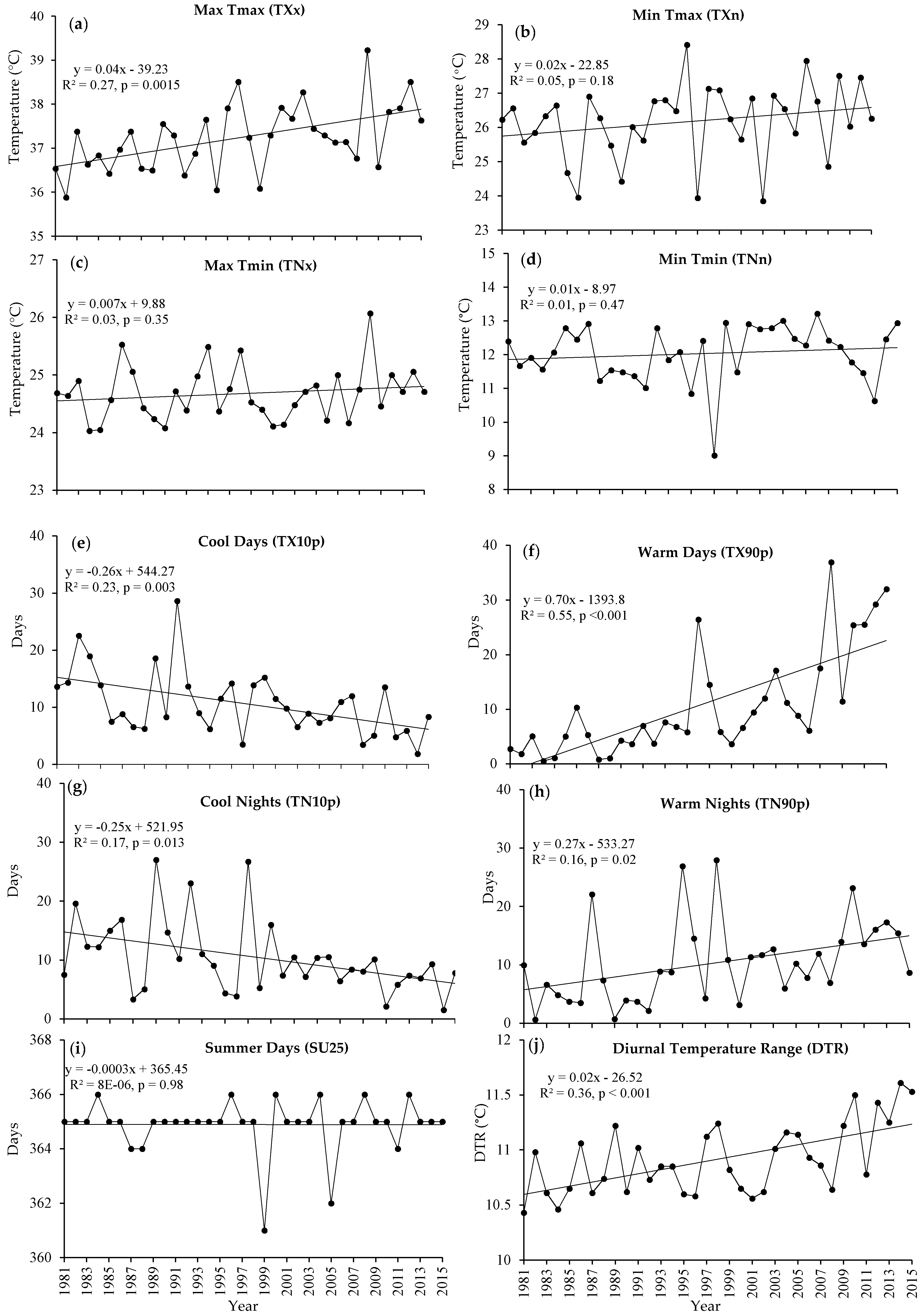
 ) sign, a significant increase with (
) sign, a significant increase with ( ), decrease with (
), decrease with ( ) sign, and significant decreases with (
) sign, and significant decreases with ( ) symbol.
) symbol.
 ) sign, a significant increase with (
) sign, a significant increase with ( ), decrease with (
), decrease with ( ) sign, and significant decreases with (
) sign, and significant decreases with ( ) symbol.
) symbol.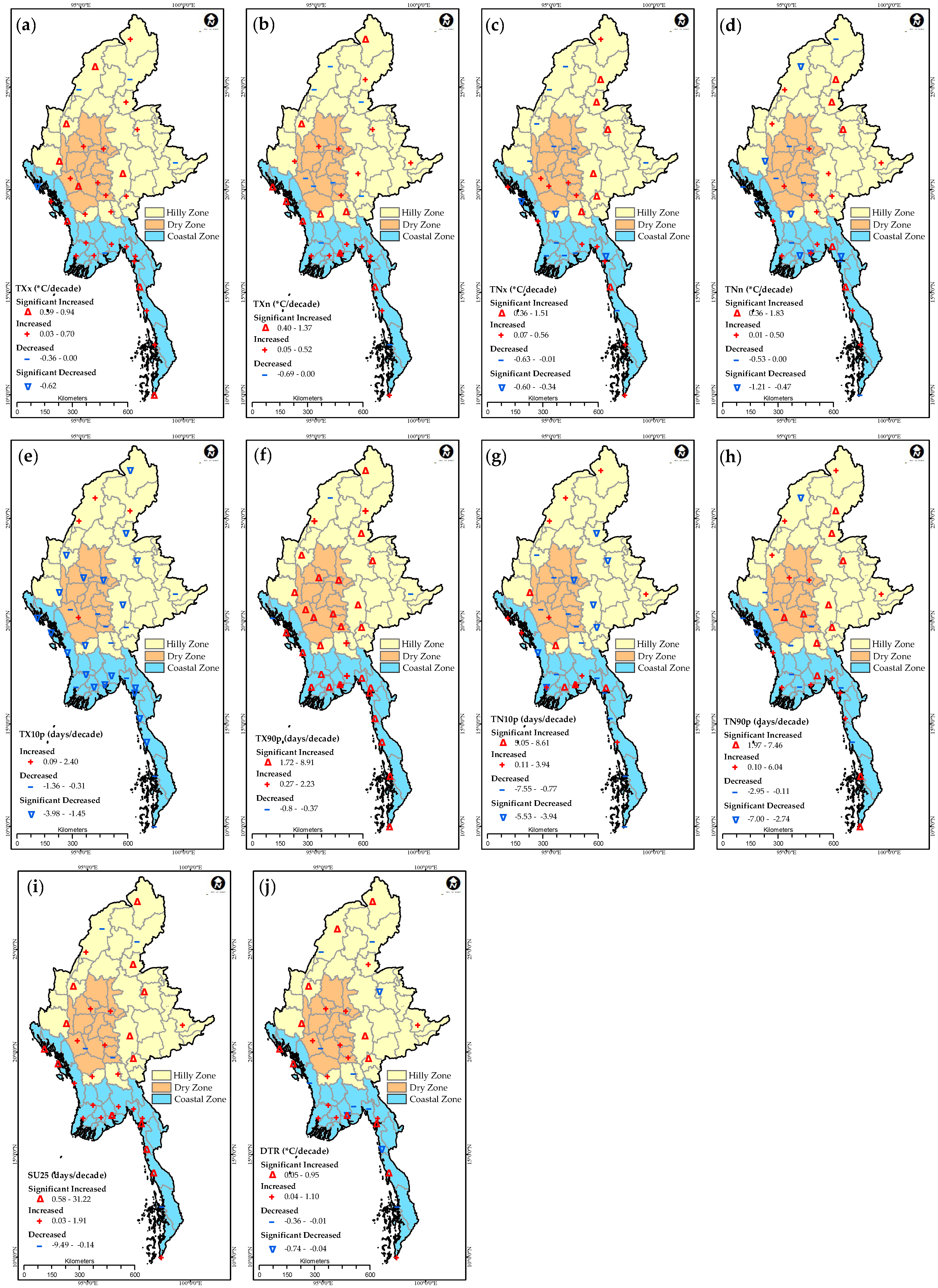
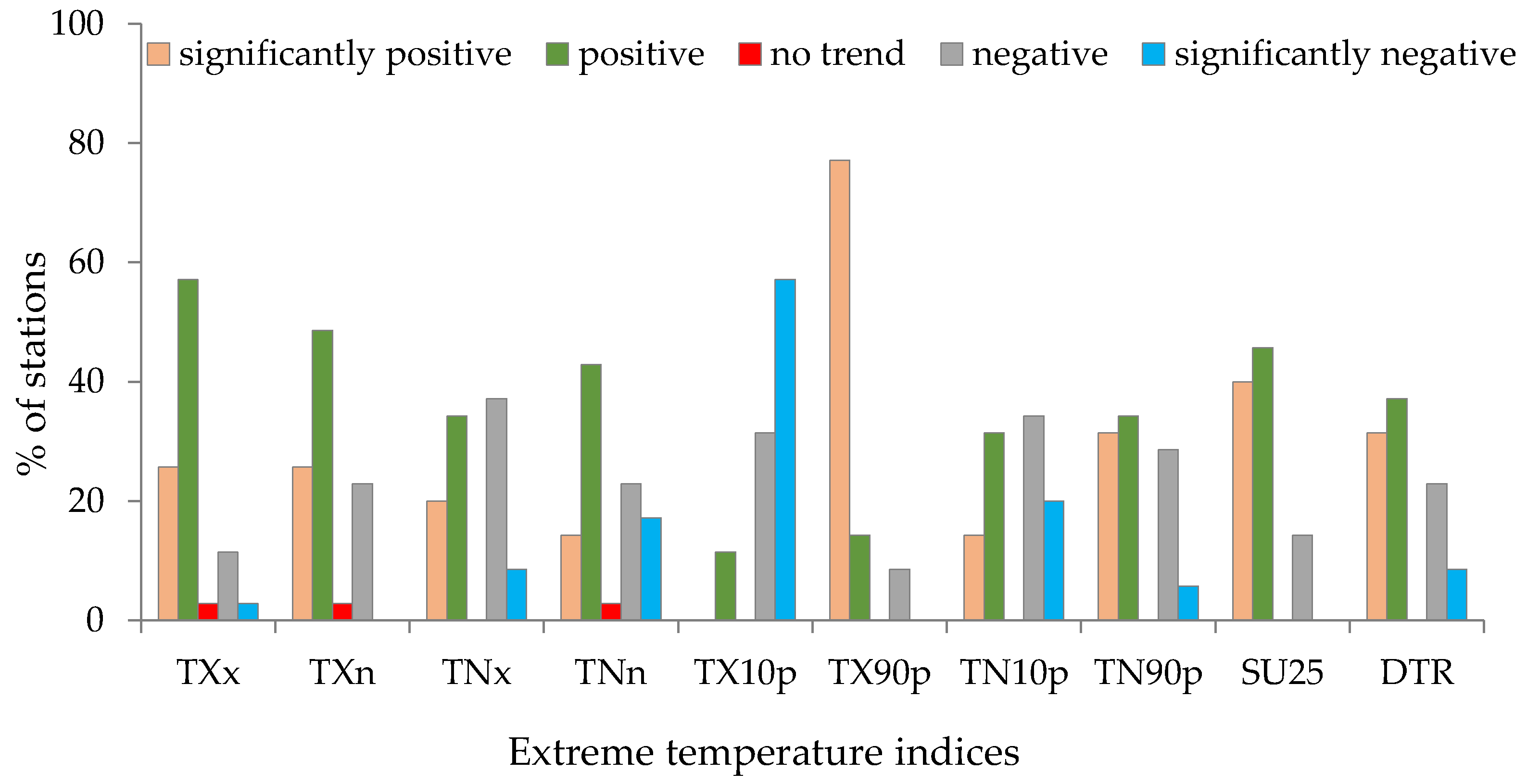
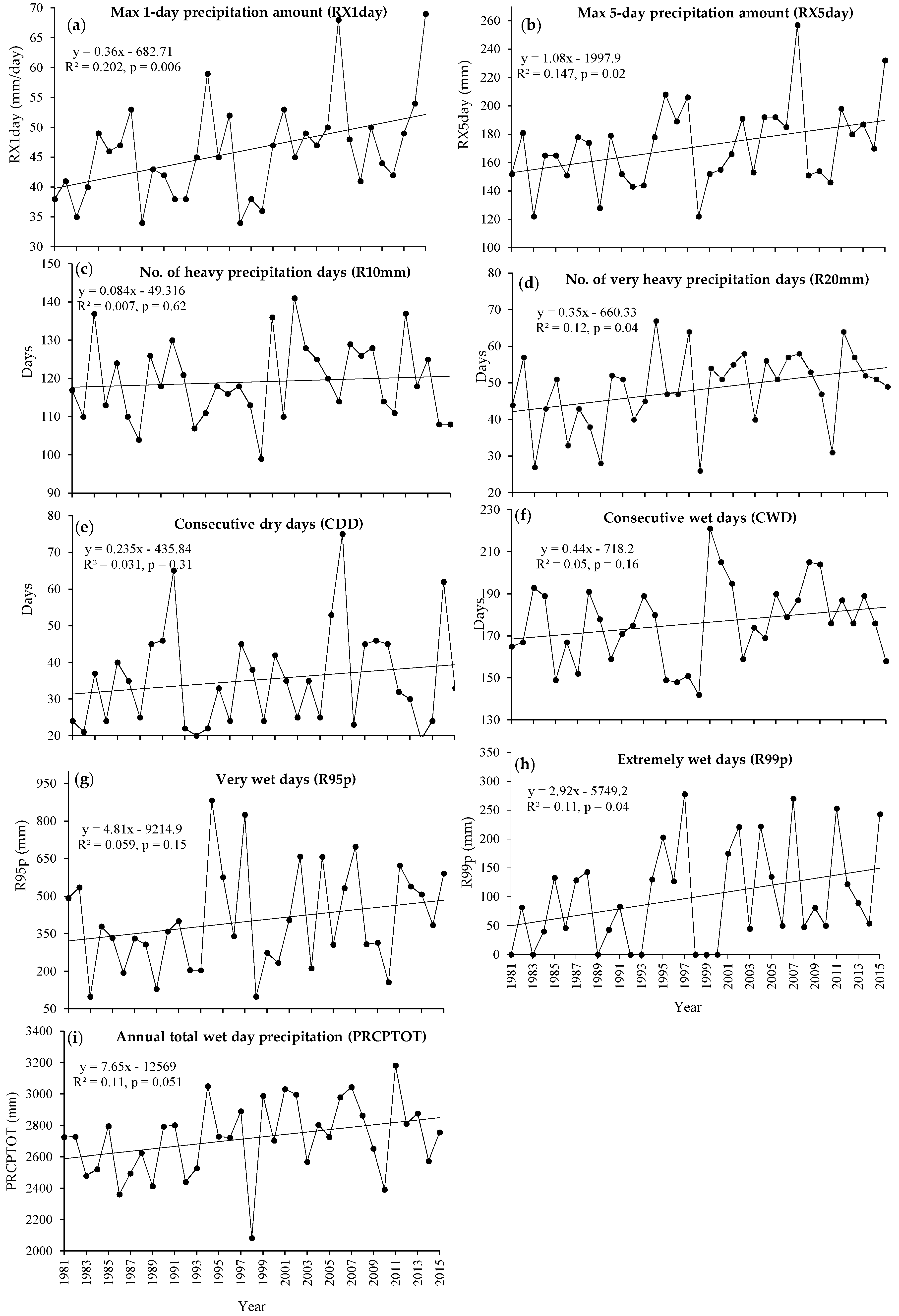
 ) sign, a significant increase with (
) sign, a significant increase with ( ), decrease with (
), decrease with ( ) sign, and significant decreases with (
) sign, and significant decreases with ( ) symbol.
) symbol.
 ) sign, a significant increase with (
) sign, a significant increase with ( ), decrease with (
), decrease with ( ) sign, and significant decreases with (
) sign, and significant decreases with ( ) symbol.
) symbol.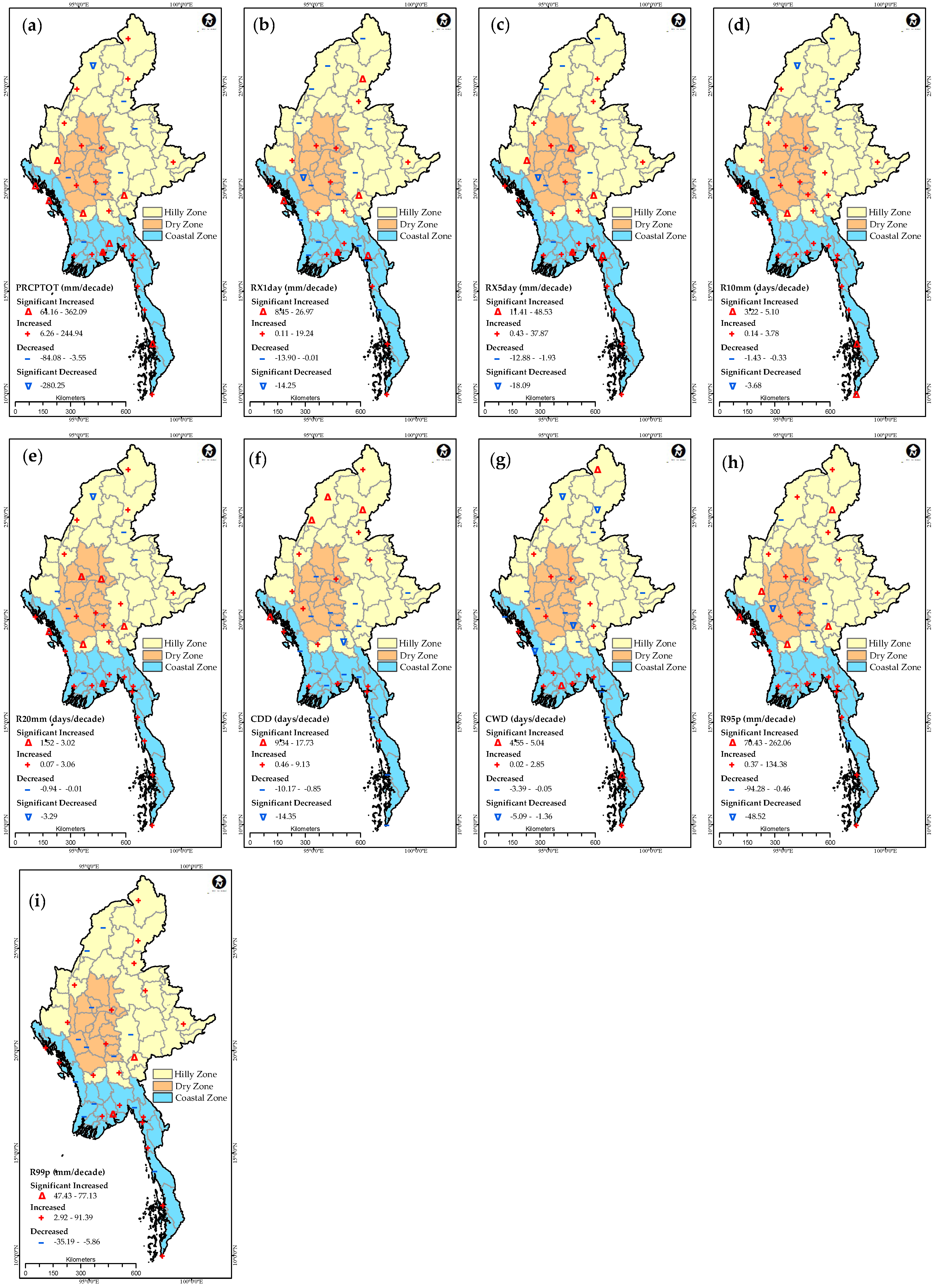
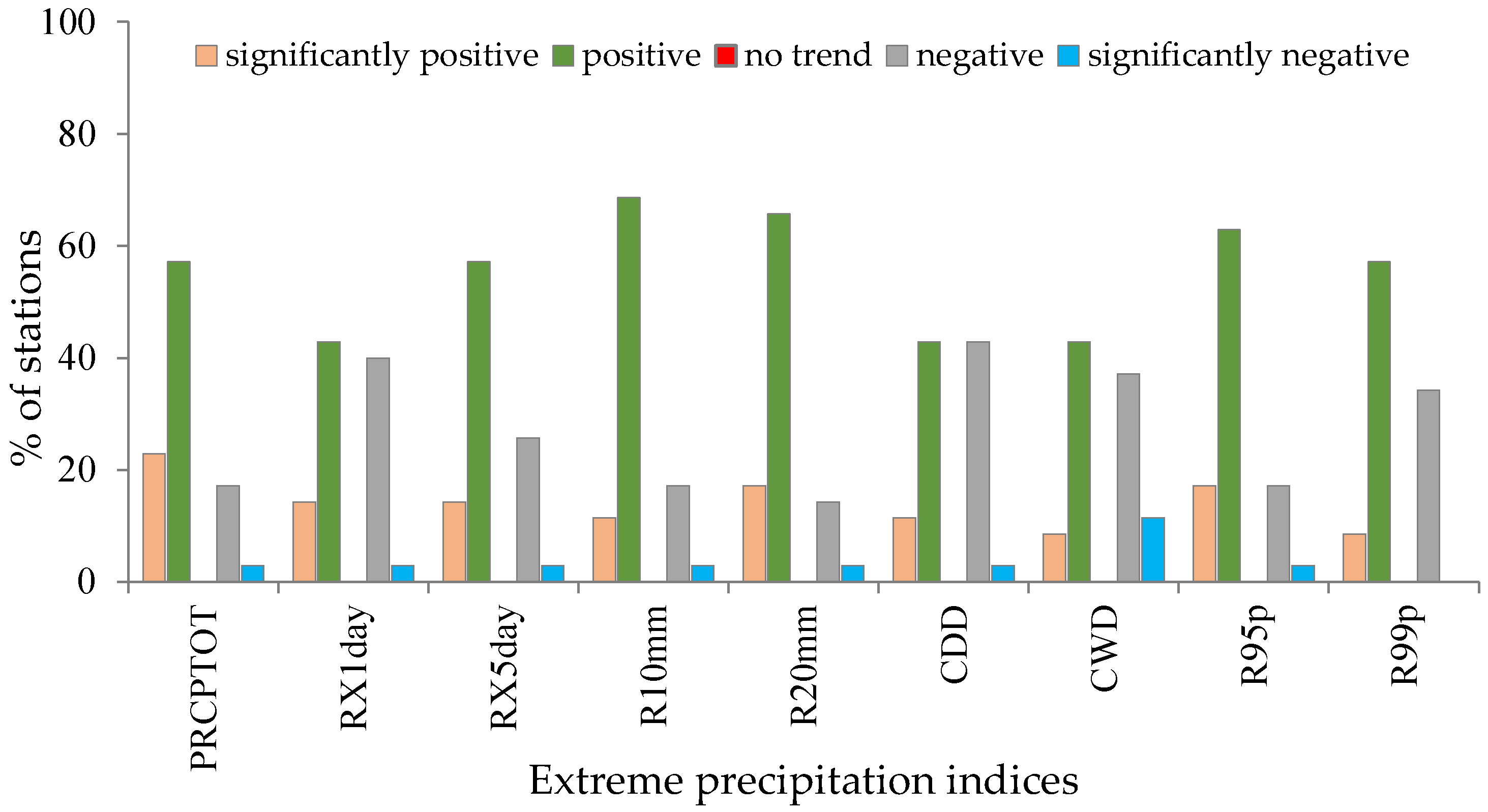
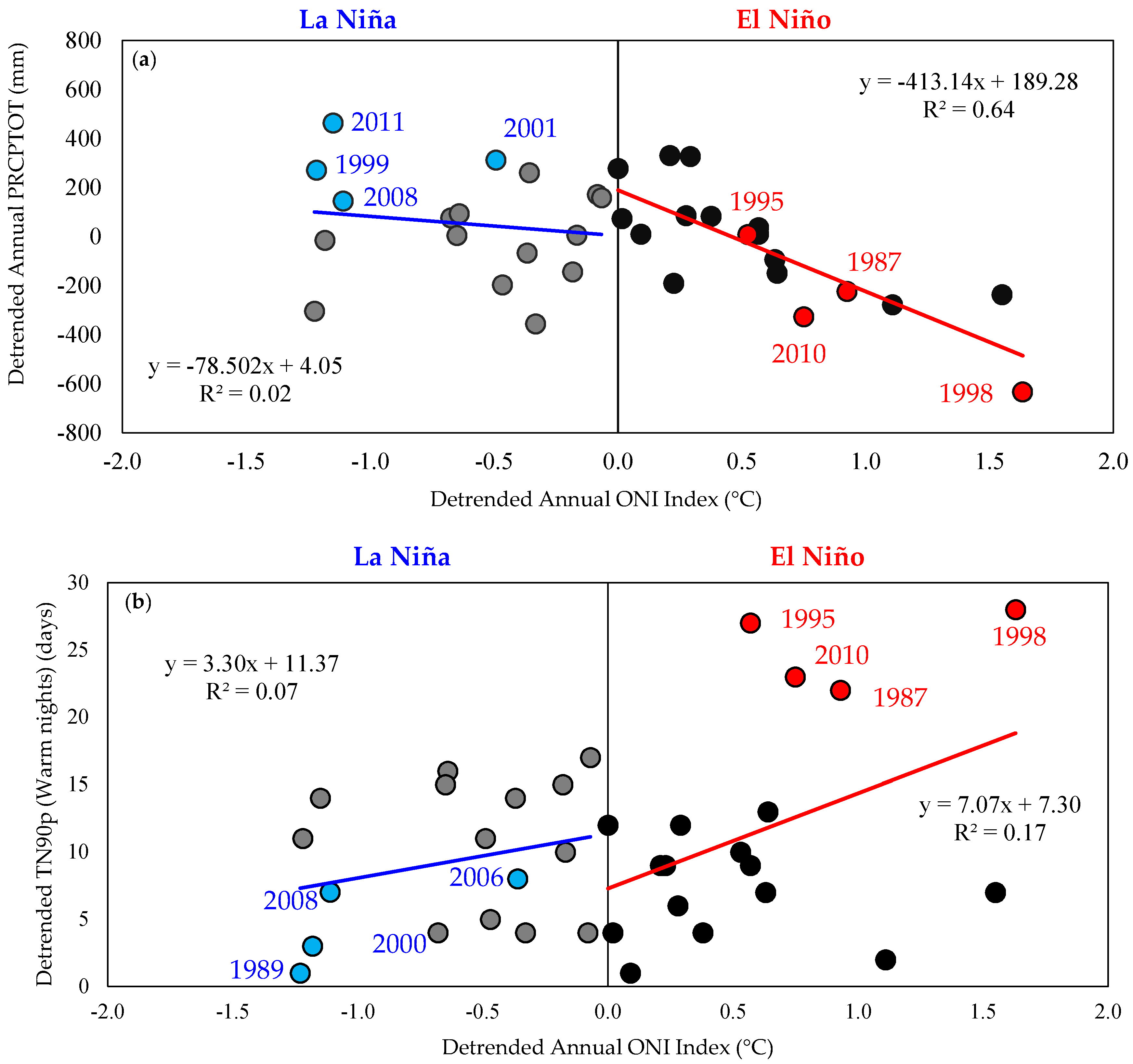
| Station Name | Station Code (WMO Number) | Latitude (DD) | Longitude (DD) | Elevation (m) | Start Year | End Year |
|---|---|---|---|---|---|---|
| Putao | 48,001 | 27.20 | 97.25 | 409 | 1968 | 2015 |
| Hkamti | 48,004 | 26.00 | 95.42 | 146 | 1966 | 2015 |
| Myitkyina | 48,008 | 25.22 | 97.24 | 145 | 1973 | 2015 |
| Homalin | 48,010 | 24.52 | 94.55 | 130 | 1966 | 2015 |
| Katha | 48,018 | 24.10 | 96.20 | 113 | 1965 | 2015 |
| Bhamo | 48,019 | 24.16 | 97.33 | 111 | 1971 | 2015 |
| Kalewa | 48025 | 23.12 | 94.18 | 109 | 1968 | 2015 |
| Falam | 48,031 | 22.55 | 93.41 | 1372 | 1981 | 2015 |
| Lashio | 48,035 | 22.56 | 97.45 | 747 | 1965 | 2015 |
| Monywa | 48,037 | 22.06 | 95.08 | 81 | 1966 | 2015 |
| Mandalay | 48,042 | 21.59 | 96.06 | 74 | 1966 | 2015 |
| Mindat | 48,045 | 21.23 | 93.57 | 1395 | 1981 | 2015 |
| Chauk | 48,052 | 20.54 | 94.50 | 82 | 1981 | 2015 |
| Meiktila | 48,053 | 20.50 | 95.50 | 214 | 1965 | 2015 |
| Taunggyi | 48,057 | 20.47 | 97.03 | 1436 | 1966 | 2015 |
| Kengtung | 48,060 | 21.18 | 99.37 | 827 | 1966 | 2015 |
| Sittwe | 48,062 | 20.08 | 92.53 | 4 | 1965 | 2015 |
| Minbu | 48,064 | 20.10 | 94.53 | 51 | 1965 | 2015 |
| Kyaukphyu | 48,071 | 19.25 | 93.33 | 5 | 1965 | 2015 |
| Pyinmana | 48,074 | 19.43 | 96.13 | 101 | 1965 | 2015 |
| Loikaw | 48,075 | 19.41 | 97.13 | 895 | 1965 | 2015 |
| Pyay | 48,077 | 18.48 | 95.13 | 58 | 1955 | 2015 |
| Taungoo | 48,078 | 18.55 | 96.28 | 47 | 1965 | 2015 |
| Thandwe | 48,080 | 18.28 | 94.21 | 9 | 1965 | 2015 |
| Hinthada | 48,087 | 17.40 | 95.25 | 26 | 1981 | 2015 |
| Bago | 48,093 | 17.20 | 96.30 | 15 | 1965 | 2015 |
| Pathein | 48,094 | 16.46 | 94.46 | 9 | 1965 | 2015 |
| Maubin | 48,095 | 16.44 | 95.39 | 3 | 1981 | 2015 |
| Mingaladon | 48,096 | 16.54 | 96.11 | 28 | 1965 | 2015 |
| Kabaaye | 48,097 | 16.46 | 96.10 | 20 | 1981 | 2015 |
| Hpaan | 48,099 | 16.45 | 97.40 | 9 | 1965 | 2015 |
| Belin | 48,100 | 17.13 | 97.14 | 61 | 1981 | 2015 |
| Mawlamyine | 48,103 | 16.30 | 97.37 | 21 | 1970 | 2015 |
| Ye | 48,107 | 15.15 | 97.52 | 3 | 1965 | 2015 |
| Dawei | 48,108 | 14.06 | 98.13 | 16 | 1965 | 2015 |
| Myeik | 48,110 | 12.26 | 98.36 | 81 | 1965 | 2015 |
| Kawthong | 48,112 | 09.58 | 98.35 | 46 | 1965 | 2015 |
| ID | Indicator | Definitions | Units |
|---|---|---|---|
| Temperature Indices | |||
| Absolute Indices | |||
| TXx | Max Tmax | Monthly maximum value of daily max temperature | °C |
| TXn | Min Tmax | Monthly minimum value of daily max temperature | °C |
| TNx | Max Tmin | Monthly maximum value of daily min temperature | °C |
| TNn | Min Tmin | Monthly minimum value of daily min temperature | °C |
| Percentile-based Indices | |||
| TN10p | Cool nights | Percentage of time when daily min temperature < 10th percentile | % |
| TX10p | Cool days | Percentage of time when daily max temperature < 10th percentile | % |
| TN90p | Warm nights | Percentage of time when daily min temperature > 90th percentile | % |
| TX90p | Warm days | Percentage of time when daily max temperature > 90th percentile | % |
| Threshold Indices | |||
| SU25 | Summer days | Annual count when daily max temperature > 25 °C | Days |
| Other Indices | |||
| DTR | Diurnal temperature range | Monthly mean difference between daily max and min temperature | °C |
| Precipitation Indices | |||
| Absolute Indices | |||
| RX1day | Max one-day precipitation amount | Monthly maximum one-day precipitation | mm |
| RX5day | Max five-day precipitation amount | Monthly maximum consecutive five-day precipitation | mm |
| Percentile-based Indices | |||
| R95p | Very wet days | Annual total precipitation from days > 95th percentile | mm |
| R99p | Extremely wet days | Annual total precipitation from days > 99th percentile | mm |
| Threshold Indices | |||
| R10 | Number of heavy precipitation days | Annual count when precipitation ≥ 10 mm | Days |
| R20 | Number of very heavy precipitation days | Annual count when precipitation ≥ 20 mm | Days |
| Duration Indices | |||
| CDD | Consecutive dry days | Maximum number of consecutives days when precipitation < 1 mm | Days |
| CWD | Consecutive wet days | Maximum number of consecutives days when precipitation ≥ 1 mm | Days |
| Other Indices | |||
| PRCPTOT | Annual total wet day precipitation | Annual total precipitation from days ≥ 1 mm | mm |
© 2018 by the authors. Licensee MDPI, Basel, Switzerland. This article is an open access article distributed under the terms and conditions of the Creative Commons Attribution (CC BY) license (http://creativecommons.org/licenses/by/4.0/).
Share and Cite
Sein, K.K.; Chidthaisong, A.; Oo, K.L. Observed Trends and Changes in Temperature and Precipitation Extreme Indices over Myanmar. Atmosphere 2018, 9, 477. https://doi.org/10.3390/atmos9120477
Sein KK, Chidthaisong A, Oo KL. Observed Trends and Changes in Temperature and Precipitation Extreme Indices over Myanmar. Atmosphere. 2018; 9(12):477. https://doi.org/10.3390/atmos9120477
Chicago/Turabian StyleSein, Kyu Kyu, Amnat Chidthaisong, and Kyaw Lwin Oo. 2018. "Observed Trends and Changes in Temperature and Precipitation Extreme Indices over Myanmar" Atmosphere 9, no. 12: 477. https://doi.org/10.3390/atmos9120477
APA StyleSein, K. K., Chidthaisong, A., & Oo, K. L. (2018). Observed Trends and Changes in Temperature and Precipitation Extreme Indices over Myanmar. Atmosphere, 9(12), 477. https://doi.org/10.3390/atmos9120477




